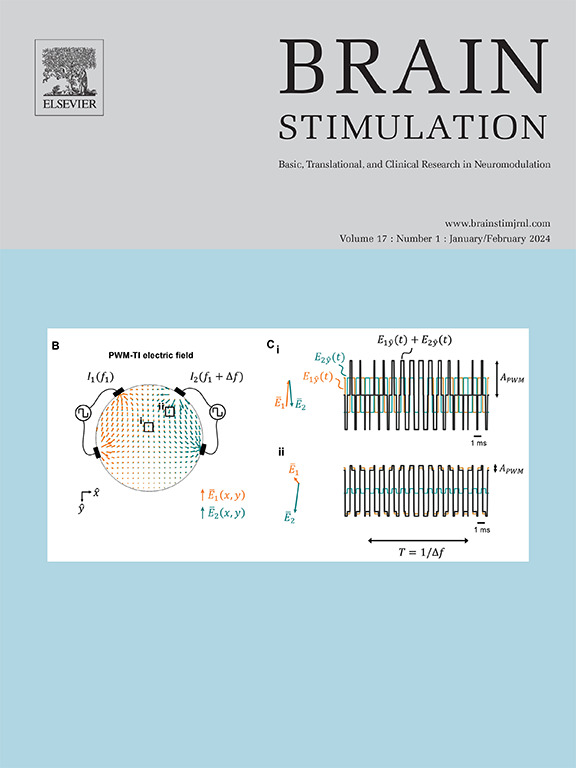Locating activation sites of TMS with opposite current directions using probabilistic modelling and biophysical axon models
IF 7.6
1区 医学
Q1 CLINICAL NEUROLOGY
引用次数: 0
Abstract
Background:
Motor responses evoked by transcranial magnetic stimulation (TMS) using posterior–anterior (PA) and anterior–posterior (AP) current directions have distinct latencies and thresholds. However, the underlying reasons for these differences remain unclear.
Objective:
To quantify the differences in activation sites between PA- and AP-TMS.
Methods:
Motor evoked potentials (MEPs) were recorded from five hand and arm muscles in nine healthy participants using both PA- and AP-TMS. Active motor thresholds were determined at 11 magnetic coil positions on the scalp. Probabilistic modelling was used to combine the measured threshold data with calculated electric field data from individual MRI-based models. This approach constructed 70 probability distributions of the activation site, dependent on the muscle and TMS direction.
Results:
Modelling indicated that both PA- and AP-TMS more likely activated structures in white matter than in grey matter. PA-TMS activation sites were primarily in the white or grey matter in the precentral gyrus, while the AP-TMS activations were deeper and more posterior and lateral, likely within white matter under the postcentral and/or precentral gyri. Tractography and biophysical axon models provided a potential explanation on the location of activation sites: AP-TMS may activate the bends of white matter axons farther from M1 than PA-TMS, such that the conduction velocity along the neural tract could potentially explain the longer MEP latency of AP-TMS. The differences in activation sites among the five hand and arm muscles were small.
Conclusion:
While a direct experimental confirmation of the activation sites is still needed, the results suggest that electric field analysis combined with tractography and biophysical axon modelling could be a useful computational tool for analysing and optimizing TMS.
利用概率模型和生物物理轴突模型定位电流方向相反的经颅磁刺激激活位点。
背景:经颅磁刺激(TMS)使用后-前(PA)和前-后(AP)电流方向引起的运动反应具有不同的潜伏期和阈值。然而,造成这些差异的根本原因尚不清楚。目的:量化PA-和ap -经颅磁刺激在激活位点上的差异。方法:采用PA- tms和AP-TMS分别记录9名健康受试者手部和手臂5块肌肉的运动诱发电位(MEPs)。在头皮上的11个磁线圈位置确定主动电机阈值。概率建模用于将测量的阈值数据与来自单个基于mri的模型的计算电场数据相结合。该方法根据肌肉和经颅磁刺激方向构建了70个激活位点的概率分布。结果:模型显示PA-和AP-TMS更可能激活白质中的结构而不是灰质。PA-TMS的激活位点主要在中央前回的白质或灰质中,而AP-TMS的激活位点更深,更靠后和外侧,可能在中央后和/或中央前回下的白质中。神经束造影和生物物理轴突模型为激活位点的位置提供了一种可能的解释:AP-TMS可能比PA-TMS激活距离M1更远的白质轴突的弯曲,因此沿神经束的传导速度可能解释AP-TMS的MEP潜伏期更长。五块手部和手臂肌肉的激活位点差异很小。结论:虽然还需要直接的实验确认激活位点,但结果表明,电场分析结合神经束成像和生物物理轴突建模可以成为分析和优化经颅磁刺激的有用计算工具。
本文章由计算机程序翻译,如有差异,请以英文原文为准。
求助全文
约1分钟内获得全文
求助全文
来源期刊

Brain Stimulation
医学-临床神经学
CiteScore
13.10
自引率
9.10%
发文量
256
审稿时长
72 days
期刊介绍:
Brain Stimulation publishes on the entire field of brain stimulation, including noninvasive and invasive techniques and technologies that alter brain function through the use of electrical, magnetic, radiowave, or focally targeted pharmacologic stimulation.
Brain Stimulation aims to be the premier journal for publication of original research in the field of neuromodulation. The journal includes: a) Original articles; b) Short Communications; c) Invited and original reviews; d) Technology and methodological perspectives (reviews of new devices, description of new methods, etc.); and e) Letters to the Editor. Special issues of the journal will be considered based on scientific merit.
 求助内容:
求助内容: 应助结果提醒方式:
应助结果提醒方式:


